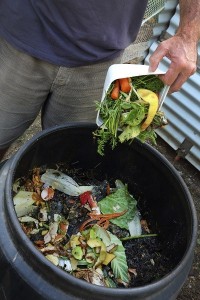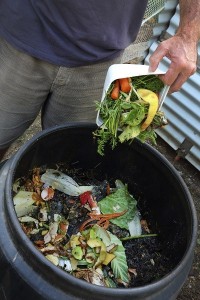 If you have a backyard garden, be sure to give it plenty of sunshine, water, and garbage.
If you have a backyard garden, be sure to give it plenty of sunshine, water, and garbage.
Wait… garbage? Yes, you read that right.
Garbage like rotting food and coffee grounds, made into compost, can be highly beneficial to garden plants. Why? It all has to do with nitrogen.
Plants need nitrogen in order to survive. There is plenty of nitrogen in the atmosphere; the problem is that plants can’t use it in the form found in the atmosphere. For this, bacteria are needed. Bacteria “fix” nitrogen, meaning that they change it into a usable form.
[am4show have=’p8;p9;p11;p38;p92;p27;p54;p78;’ guest_error=’Guest error message’ user_error=’User error message’ ]
This is where the garbage comes in. Bacteria break down the garbage by eating it. When other organisms living in the soil, particularly worms, eat the bacteria, the nutrients they have stored up are released. The result is soil far more rich in nutrients.
So, how do you create your own compost pile to create plenty of garbage for your garden’s bacteria to enjoy? Well, you already have the garbage, which is a good first start. Next, you’ll want to get a compost bin. Garden supply stores sell bins, although you could also make one with wood and chicken wire. For even simpler compost bins, a pit in the ground or plastic garbage bag with holes in it will work, although you’ll need to be sure to air out the plastic bag every couple days.
Fill your bin with 1/3 brown material (dead leaves or plants are good), 1/3 vegetation, and 1/3 soil. Then, pile on the garbage! Add kitchen waste, grass clippings, dry leaves, dead plants, shredded newspaper, lint from your clothes dryer, and pet hair. The ideal compost heap will have a 25 to one ratio of things like dead leaves and newspapers, which are high in carbon to grass and other plants, which are high in nitrogen. Adding cattle, horse, or chicken manure is a great idea. Trash to avoid are bones, meat, and fat (all of which can attract pests), human or pet waste (which can spread disease), and weeds or diseased plants (which can re-introduce the weed or disease into your garden.)
[/am4show]
Keep your compost heap moist, but not soggy and turn it with a pitchfork or spade to add air into the mix. Once your compost bin is going strong, you can add it to your garden for improved plant growth!


There is no video for this lesson. Everything you need is provided in the article.
no video?
To load the page? Or do the experiment? Or…?
Also it takes a LONG TIME
As soon as I saw the word *gold* I tapped the link XD
Okay, now 5hats what you call cool
Yeah!
It’s not real gold, it’s a look-alike called “brass” which is made by fusing together the zinc and copper layers.
i am reading this over and over again …………
but i dont get it
how does it turn to gold?????????